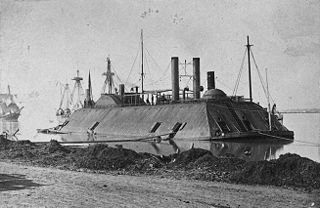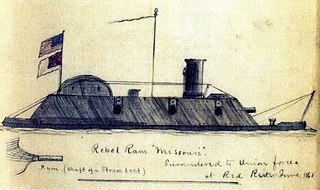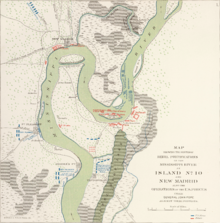
CSS Arkansas was the lead ship of her class of two casemate ironclads built for the Confederate States Navy during the American Civil War. Completed in 1862, she saw combat in the Western Theater when she steamed through a United States Navy fleet at Vicksburg in July. Arkansas was set on fire and destroyed by her crew after her engines broke down several weeks later. Her remains lie under a levee above Baton Rouge, Louisiana at 30°29′14″N91°12′5″W.

The Battle of Island Number Ten was an engagement at the New Madrid or Kentucky Bend on the Mississippi River during the American Civil War, lasting from February 28 to April 8, 1862. Island Number Ten, a small island at the base of a tight double turn in the river, was held by the Confederates from the early days of the war. It was an excellent site to impede Union efforts to invade the South by the river, as ships had to approach the island bows on and then slow to make the turns. For the defenders, however, it had an innate weakness in that it depended on a single road for supplies and reinforcements. If an enemy force managed to cut that road, the garrison would be isolated and eventually be forced to surrender.

CSS Oregon was a wooden sidewheel steamer that served as a gunboat in the Confederate States Army during the American Civil War. Built in 1846 for the Mobile Mail Line, she transported mail between New Orleans, Louisiana, and Mobile, Alabama, before the war. In 1861, she was seized by the Governor of Louisiana, Thomas Overton Moore, and served as a blockade runner before being selected for use by the Confederate Army. After transferring men and supplies to Ship Island, she was formally converted into a gunboat and armed with four cannon. Remaining behind on Lake Pontchartrain when many Confederate warships were transferred up the Mississippi River, Oregon served in the Mississippi Sound and Pass Christian areas. She took part in several minor actions involving USS New London, two of which resulted in the Confederates moving into shallow water to avoid close-range action, and the third ending when the Confederate ships abandoned the Pass Christian area. In April 1862, Union pressure confined her and other Confederate ships to Lake Pontchartrain. Later that month, with Union forces closing in on New Orleans, Oregon was sunk as a blockship. Her wreck was removed and destroyed in the early 1870s.

CSS Fredericksburg was a casemate ironclad that served as part of the James River Squadron of the Confederate States Navy during the American Civil War. Laid down in 1862 and Launched the following year, she did not see action until 1864 due to delays in receiving her armor and guns. After passing through the obstructions at Drewry's Bluff in May 1864, she participated in several minor actions on the James River and fought in the Battle of Chaffin's Farm from September 29 to October 1. On January 23 and 24, 1865, she was part of the Confederate fleet at the Battle of Trent's Reach, and was one of only two Confederate ships to make it past the obstructions at Trent's Reach. After the Confederate attack failed, Fredericksburg withdrew with the rest of the James River Squadron. On April 3, as the Confederates were abandoning Richmond, Fredericksburg and the other vessels of the James River Squadron were burned. Her wreck was located in the 1980s, buried under sediment.

USS Varuna was a screw steamer acquired by the Union Navy during the American Civil War. Under construction in 1861, she was purchased incomplete on 31 December. After being commissioned in February 1862, she traveled to join the West Gulf Blockading Squadron. Varuna was present when Flag Officer David Glasgow Farragut led an attack against Confederate positions at Fort Jackson and Fort St. Philip on 24 April. During the action, Varuna ran ahead of the other Union ships, and was engaged in a chase with the Louisiana gunboat Governor Moore. After closing in on the Union ship, Governor Moore rammed Varuna twice, with the gunboat CSS Stonewall Jackson adding a third blow. Varuna sank within 15 minutes, but Farragut was able to capture the city of New Orleans, Louisiana.
CSSIsondiga was a wooden gunboat that served in the Confederate States Navy during the American Civil War. Designed according to Matthew Fontaine Maury's plan to produce a large number of small vessels to swamp the Union blockade, Isondiga was one of only two or three of these Maury gunboats actually completed, and the only one completed as designed. The Maury gunboats project had been almost entirely cancelled in favor of ironclad production after the Battle of Hampton Roads. Isondiga was built in Savannah, Georgia, and was transferred to the Confederate Navy in January 1863 to begin the fitting out process. At this time, she was commanded by Lieutenant Joel S. Kennard.

The siege of Fort Pulaski concluded with the Battle of Fort Pulaski fought April 10–11, 1862, during the American Civil War. Union forces on Tybee Island and naval operations conducted a 112-day siege, then captured the Confederate-held Fort Pulaski after a 30-hour bombardment. The siege and battle are important for innovative use of rifled guns which made existing coastal defenses obsolete. The Union initiated large-scale amphibious operations under fire.

The Battle of Elizabeth City of the American Civil War was fought in the immediate aftermath of the Battle of Roanoke Island. It took place on 10 February 1862, on the Pasquotank River near Elizabeth City, North Carolina. The participants were vessels of the U.S. Navy's North Atlantic Blockading Squadron, opposed by vessels of the Confederate Navy's Mosquito Fleet; the latter were supported by a shore-based battery of four guns at Cobb's Point, near the southeastern border of the town. The battle was a part of the campaign in North Carolina that was led by Major General Ambrose E. Burnside and known as the Burnside Expedition. The result was a Union victory, with Elizabeth City and its nearby waters in their possession, and the Confederate fleet captured, sunk, or dispersed.

Seth Ledyard Phelps was an American naval officer, and in later life, a politician and diplomat. Phelps received his first commission in United States Navy as a midshipman aboard the famous USS Independence. He served patrolling the coast of West Africa guarding against slavers. During the Mexican–American War he served on gunboats, giving support to Winfield Scott's army, and later served in the Mediterranean and Caribbean squadrons.

CSS General M. Jeff Thompson was a warship which served in the River Defense Fleet of the Confederate States of America during the American Civil War. Purchased in January 1862, the vessel was operated by the Confederate States Army and named after M. Jeff Thompson, an officer in the Missouri State Guard. She was equipped with a ram and armored as a cottonclad. General M. Jeff Thompson participated in the Battle of Plum Point Bend in May 1862, before being sunk on June 6 in the Battle of Memphis. Her wreck remained on the floor of the Mississippi River until it was removed by a snagboat in July 1867; it had caused a shipwreck about six months earlier when another vessel struck it.

The Battle of Lucas Bend took place on January 11, 1862, near Lucas Bend, four miles north of Columbus on Mississippi River in Kentucky as it lay at the time of the American Civil War. In the network of the Mississippi, Tennessee and Ohio rivers, the Union river gunboats under Flag Officer Andrew Hull Foote and General Ulysses S. Grant sought to infiltrate and attack the Confederate positions in Tennessee. On the day of the battle, the Union ironclads Essex and St Louis, transporting troops down the Mississippi in fog, engaged the Confederate cotton clad warships General Polk, Ivy and Jackson and the gun platform New Orleans at a curve known as Lucas Bend in Kentucky. The Essex, under Commander William D. Porter, and the St Louis forced the Confederate ships to fall back after an hour of skirmishing during which the Union commander was wounded. They retreated to the safety of a nearby Confederate battery at Columbus, where the Union vessels could not follow.

CSS Missouri was a casemate ironclad built by the Confederate States Navy during the American Civil War. Her propulsion machinery was taken from an existing steamboat, her armor was railroad T-rails, and she was armed with three captured cannon. She was difficult to steer and leaked badly. Additional equipment had to be added to bring allow her to reach her intended speed. Completed during 1863 on the Red River, she was trapped in the Shreveport, Louisiana, area by low water and never saw combat. The vessel's crew had desertion issues and some of her crewmen were pulled from the army. After traveling downriver for the first time, the ship was surrendered in June 1865 to the United States Navy—the last Confederate ironclad to be handed over—and sold in November.

CSS Tuscaloosa was an ironclad warship that served in the Confederate States Navy during the American Civil War. Construction began in May 1862, under a contract with Henry D. Bassett. Her engines were taken from the steamboat Chewala, and she was armored with 4 inches (10 cm) of iron and armed with four cannons. In January 1863, she was launched, and traveled down to Mobile, Alabama for service on Mobile Bay. Both Tuscaloosa and her sister ship CSS Huntsville were found to be too slow for practical use, and were relegated to service as floating batteries. Union forces captured Mobile in April 1865, and Tuscaloosa was scuttled on April 12, as she was unable to escape due to an inability to steam against the current on the Spanish River. Her wreck was discovered in the 1980s.

CSS Pickens was a Cushing-class schooner revenue cutter that saw service in the navies of the United States and Confederate States of America. Built as Robert McClelland in Somerset, Massachusetts, in 1853, she served along the coasts of Louisiana and Texas before transferring her crew and officers to USRC Washington in 1859 and heading to New York for repairs. In 1860, Robert McClelland reported to South West Pass, Mississippi, and was permanently assigned to New Orleans, Louisiana, later that year. After the 1861 secession of Louisiana, her commander turned her over to the state. She entered Confederate service on February 18 and was renamed Pickens. Pickens played a minor role in the Battle of the Head of Passes before being burned to prevent its capture on April 25, 1862, after Union Navy forces entered New Orleans.
CSS Tuscarora was a sidewheel steamer that briefly served as a gunboat in the Confederate States Navy at the beginning of the American Civil War. She was about 100 feet (30 m) long, displaced 400 short tons, and was manned by a 25-man crew. The vessel was purchased in 1861 from the Southern Steamship Company by Confederate authorities in New Orleans, Louisiana. Armed with two cannons, Tuscarora was engaged in the Battle of the Head of Passes on October 12, 1861. Ordered up the Mississippi River to Columbus, Kentucky, in November, she was destroyed on November 23, 1861, when a fire of unknown origin started in her boilers and spread to the ship's munitions.
CSS Maurepas was a sidewheel steamer that briefly served as a gunboat in the Confederate States Navy during the American Civil War. Built in 1858 in Indiana as Grosse Tete, the vessel was used in commercial trade until 1860 and then delivered mail until 1861, when she was acquired by the Confederate Navy.
CSS Carondelet was a sidewheel steamer that served in the Confederate States Navy during the American Civil War. Construction for the vessel started in 1861, and she was launched on January 25, 1862, and commissioned on March 16. Her sister ship was CSS Bienville. On April 4, Carondelet, along with CSS Oregon and CSS Pamlico, took part in a small naval action near Pass Christian against USS New London, USS John P. Jackson, and the troop transport USS Henry Lewis. Carondelet suffered damage to her wheel during the fight, and likely fired the only two shots that struck John P. Jackson. Later that month, with the Confederates abandoning New Orleans, Louisiana, Carondelet was scuttled by her crew in either Lake Pontchartrain, the Tchefuncte River, or the Bogue Falaya River.
CSS Pamlico was a sidewheel steamer that served in the Confederate States Navy during the early stages of the American Civil War. Originally a passenger vessel on Lake Pontchartrain, she was purchased by Confederate authorities on July 10, 1861, and converted into a gunboat. She participated in two minor naval actions in the vicinities of Horn Island and Ship Island in December, before taking part in two more small battles defending the Pass Christian area in March and April 1862. In late April, Union Navy ships passed the defenses of New Orleans, Louisiana. After ferrying Confederate troops out of the city, Pamlico was burned by her crew on Lake Pontchartrain on April 25 to prevent capture.
CSS Pontchartrain was a gunboat that served in the Confederate States Navy during the American Civil War. Built in 1859 for passenger and cotton trade, she was purchased by the Confederates in October 1862. After seeing action against Union land positions during the campaigns for New Madrid, Missouri, and Island Number Ten, she was transferred to serve on the Arkansas River and the White River. In June 1862, two of her cannons were taken to a land fortification at St. Charles, Arkansas, where part of her crew saw action in the Battle of St. Charles while manning the guns. Her other cannons were then offloaded at Fort Hindman, where more of her crew were captured while fighting on land at the Battle of Arkansas Post in January 1863. Pontchartrain herself remained inactive at Little Rock, Arkansas, and was burned to prevent capture in September 1863 when the Confederates evacuated the city.

The Huntsville-class ironclads consisted of two casemate ironclads ordered by the Confederate States Navy in 1862 to defend Mobile, Alabama, during the American Civil War. Completed the following year, they used propulsion machinery taken from steamboats, and were intended to be armored with 4 inches (102 mm) of wrought iron and armed with four cannons. Both CSS Tuscaloosa and her sister ship CSS Huntsville were found to be too slow for practical use, and were relegated to service as floating batteries. Union forces captured Mobile in April 1865, and the sisters were scuttled on April 12, as they were unable to escape due to an inability to steam against the current on the Spanish River.














